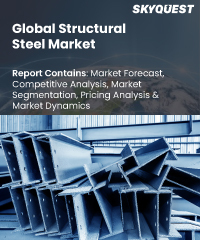
Report ID: SQMIG15O2025

Report ID:
SQMIG15O2025 |
Region:
Global |
Published Date: April, 2024
Pages:
184
|
Tables:
62 |
Figures:
75
Global Structural Steel Market size was valued at USD 105.05 Billion in 2022 and is poised to grow from USD 110.83 Billion in 2023 to USD 170.09 Billion by 2031, at a CAGR of 5.5% during the forecast period (2024-2031).
The primary purpose of the global structural steel market is to fulfill the growing demand for reliable and robust construction materials. Structural steel offers numerous advantages, including high strength-to-weight ratio, cost-effectiveness, and sustainability. As a result, it is extensively used in the construction sector worldwide. The market serves as a platform for manufacturers to produce and supply structural steel products, while also meeting the diverse requirements of construction projects across different regions.
Several factors drive the growth of the global structural steel market. Firstly, the rapid urbanization and industrialization in emerging economies, such as India, China, and Brazil, have led to increased construction activities, thereby boosting the demand for structural steel. Secondly, the rising investment in infrastructure development projects, including roads, railways, and airports, further fuels the market growth. Moreover, the superior properties of structural steel, such as its ability to withstand extreme weather conditions and seismic events, contribute to its growing popularity in construction. Despite the positive outlook, the global structural steel market faces certain restraining factors. One significant factor is the volatility in raw material prices, particularly for iron ore and scrap metal. Fluctuations in these prices can significantly impact the overall production cost and profit margins for manufacturers. The structural steel market also encounters specific challenges. One of the major challenges is the competition from alternative construction materials, such as concrete and wood. The preference for these materials can vary based on factors like project specifications, cost considerations, and sustainability goals. Another challenge lies in the fragmented nature of the market, with numerous small and medium-sized manufacturers operating in different regions. This fragmentation often leads to intense price competition and the need for differentiation strategies to gain a competitive edge.
The global structural steel market presents several opportunities for growth and innovation. With the increasing focus on sustainable construction practices, there is a rising demand for green and energy-efficient steel products. Manufacturers can capitalize on this trend by developing eco-friendly steel variants and promoting their benefits. Furthermore, advancements in technology, such as computer-aided design (CAD) and building information modeling (BIM), provide opportunities for improved product design, precision, and optimization. The global structural steel market serves the purpose of meeting the demand for durable and versatile construction materials.
US Structural Steel Market is poised to grow at a sustainable CAGR for the next forecast year.
Our industry expert will work with you to provide you with customized data in a short amount of time.
REQUEST FREE CUSTOMIZATIONWant to customize this report? This report can be personalized according to your needs. Our analysts and industry experts will work directly with you to understand your requirements and provide you with customized data in a short amount of time. We offer $1000 worth of FREE customization at the time of purchase.

Report ID: SQMIG15O2025